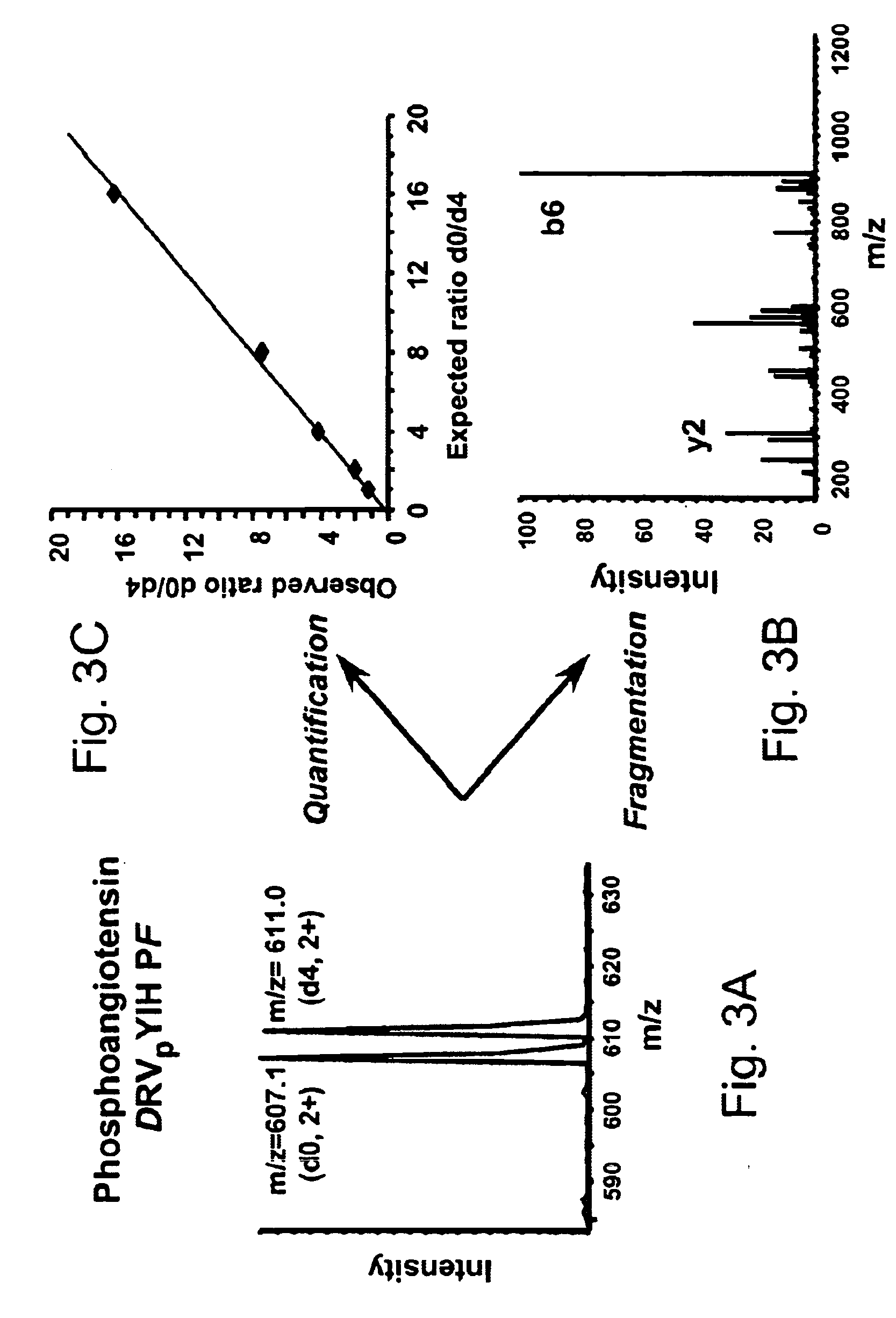Selective labeling and isolation of phosphopeptides and applications to proteome analysis
a proteome analysis and labeling technology, applied in the field of selective labeling and isolation of phosphopeptides, can solve the problems of limiting the dynamic range of the technique, limiting the sample throughput, and no protein analytical technology approaching the throughput and level of automation of genomic technology, so as to facilitate separation, isolation and detection of phosphoproteins
- Summary
- Abstract
- Description
- Claims
- Application Information
AI Technical Summary
Benefits of technology
Problems solved by technology
Method used
Image
Examples
example 1
ptide Isolation Procedure
[0084]Peptide samples were dried, and then subjected to the method shown in FIG. 1A according to the following steps. 1) Peptide mixture was resuspended in 50% (v / v) of 0.1 M phosphate buffer (pH 11) / acetonitrile. 0.1 M of t-Butyl-dicarbonate (tBoc) was added for 4 hours at room temperature. 2) Acetonitrile was removed under reduced pressure. Samples were made to 1 M ethanolamine, 25 mM N-hydroxysuccinimide (NHS) and 0.5 M of N,N′-dimethylaminopropyl ethyl carbodiimide HCl (EDC) and incubated 2 hours at room temperature. 3) 10% trifluoroacetic acid (TFA) was added for 30 minutes at room temperature. Longer treatment under these conditions did not detrimentally affect the results. Samples can be neutralized at this point, but neutralization as found to have no significant effect on results. Samples were then desalted on and recovered from a C18 column (Waters Associates, Milford, Mass. WAT 023590) using elution with 80% acetonitrile, 0.1% TFA. 4) Peptides wer...
example 2
[0085]Two separate samples of equal amounts of phosphoangiotensin peptide were analyzed by the method of this invention. The carboxylic acid groups in the two different samples were blocked (leaving phosphate groups free as described above) by either light ethanolamine (d0-ethanolamine) or heavy ethanolamine (d4-ethanolamine, HOCD2CD2NH2). Phosphoangiotensin contains two carboxylic acid groups, so that the mass difference for the [M+2H]2+ ion is 4 for the differentially labeled peptides. The results of mass spectrometric analysis of the differentially labeled samples that were subjected to selective labeling and separation of phosphopeptides of this invention is illustrated in FIGS. 3A-C. A doublet of peaks [M+2H]2+ at m / z=607 and 611, due to light and heavy labeled samples, respectively, is observed as expected. Further the relative ratios of the two peaks is about 1:1 as expected. The CID spectrum of these peaks is similar to that of the unprotected peptide, except for the fragmen...
example 3
of Phosphopeptides from β-casein
[0089]The methods of this invention were also used to purify and detect phosphopeptides from bovine β-casein, a well-characterized phosphoprotein. The peptide was labeled as described in Example 2. A tryptic digest of the phosphoprotein was analyzed by microcapillary LC-MS / MS. As shown in FIG. 4A, numerous peptides were observed for the untreated β-casein digest. The peptide indicated in FIG. 4A was a doubly charged ion at m / z=1031.6. When selected for fragmentation via collision induced dissociation (CID) (FIG. 4C) (Papayannopoulos, I. A. (1995), “The interpretation of collision-induced dissociation tandem mass spectra of peptides,”Mass Spectrometry Rev. 14,49-73), its fragment ion spectrum exhibited mostly the y-ion series typical for low energy peptide fragmentation and an additional major signal at m / z=983.0 corresponding to a loss of 98 Da due to the loss of the H3PO4 group from the parent ion(Jonscher, K. R. and Yates, J. R. III (1997), “Matrix-...
PUM
| Property | Measurement | Unit |
|---|---|---|
| Acidity | aaaaa | aaaaa |
| Fluorescence | aaaaa | aaaaa |
| Affinity | aaaaa | aaaaa |
Abstract
Description
Claims
Application Information
 Login to View More
Login to View More - R&D
- Intellectual Property
- Life Sciences
- Materials
- Tech Scout
- Unparalleled Data Quality
- Higher Quality Content
- 60% Fewer Hallucinations
Browse by: Latest US Patents, China's latest patents, Technical Efficacy Thesaurus, Application Domain, Technology Topic, Popular Technical Reports.
© 2025 PatSnap. All rights reserved.Legal|Privacy policy|Modern Slavery Act Transparency Statement|Sitemap|About US| Contact US: help@patsnap.com



